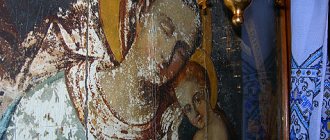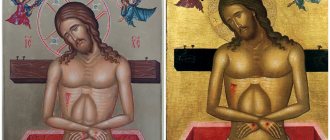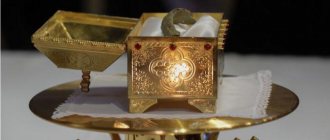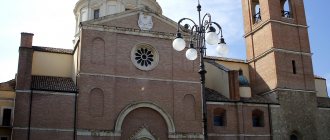Clothes of Christ
As far as we know from the Holy Scriptures, clothing was divided into upper and lower. And our Lord also wore a double robe. Jesus wore a tunic over his lower robe. The Holy Scriptures are silent about some details related to the Lord's clothes, for example, what material they were made from: linen or wool - but, in any case, not from both of these materials, since according to the Law of Moses this was not allowed. We do not know what color the tunic was: white, gray, black, or maybe painted a different color. But it should be said about what we know: “When the soldiers crucified Jesus, they took His clothes and divided them into four parts, a part for each soldier, and a tunic; The tunic was not sewn, but entirely woven on top. And so they said to each other: “Let us not tear him apart, but let us cast lots for him, whose it will be, so that what is said in Scripture may be fulfilled: “They divided My garments among themselves, and cast lots for My clothing.” This is what the soldiers did” (John 19:23-24). So, we see that Jesus had other clothes in addition to the tunic, so they were divided into four parts. True, it is not very clear why the soldiers liked or needed the Lord’s clothes. Before the crucifixion, Jesus was severely beaten, and His Body was bloody, and His clothes may have been stained with Blood, but despite this, the soldiers cast lots for it. Most likely, they took it not as a material asset, but as a trophy or as a relic for memory, although it can be assumed that the tunic also had some material value. The chiton was not sewn, but entirely woven on top. There were no seams in the chiton. At one time, a woman suffering from bleeding touched the Lord’s robe and was healed by faith. One day Jesus took off His outer garment and washed the feet of His disciples. The tunic of the Lord woven on top is also a wonderful prototype of the unity of the Church of Jesus Christ. From above means from above, from God. Without seams - means the complete merging of Jews and Gentiles. Here the divisions between male and female, between slave and master in the matter of salvation are erased.
For a short time, the Lord’s clothing became a scarlet robe, in which they clothed Him, wanting to humiliate Him as much as possible, while Jesus is the King of kings and Lord of lords. Christ revealed His glory to the three disciples on the Mount of Olives, the Mount of Transfiguration. Having awakened, the disciples saw their Teacher in heavenly splendor: His face shone like the sun, His clothes became white as light, shining, very white, like snow, as a whitener on earth cannot bleach (Matthew 17:2, Mark 9:3 , Luke 9:29). A bleacher is a person who bleaches fabric until it is white. White color symbolizes purity, righteousness, holiness. So, on the Mount of Olives, Jesus’ clothes were so white that the Evangelist Mark considered it necessary to note this with the words: “... as on earth a whitener cannot whiten” (Mark 9:3). That is, Divine righteousness and holiness cannot be achieved through human efforts and efforts - this is achieved with the help of the Heavenly Whitener, Who cleanses us with His precious Blood.
The Apostle John saw a similar picture on the island of Pa (Rev. 1:12-18).
Matinee No. 51
Purple Robe
The second time they put someone else’s clothes on Jesus in the courtyard of the praetorium, the place where Pontius Pilate lived.
After returning from Herod's palace, Jesus was given back His normal clothes. This was done so that He could again go to trial before Pilate in it, not in the bright toga of an innocent man, but as a defendant whose fate had not yet been decided.
► Se Man. Bartolome Esteban Murillo. Mid-17th century
Pilate did not want to execute Jesus, because he saw that they accused Him in vain. But the Jews shouted louder and louder, “Crucify Him!” And there was so much hatred in their cry that Pilate understood that it would not be possible to simply let Jesus go. The Jews will simply stone Him to death without any trial. Then, in order to satisfy the rage of the Jews, Pilate decided to punish Jesus, but at his own discretion. He said, “So you have brought this man to me as one who troubles the people. And so, I examined the case in front of you and did not find him guilty of anything. Herod also considers Him innocent, nothing was found in Him worthy of death. So, having punished me, I will release Him.”
After these words, Pilate handed Jesus over to his Praetorian soldiers to be killed. They dragged Him into the courtyard, tore off His clothes and began to brutally beat Him with whips - heavy whips made of leather.
And already on the beaten, disfigured Jesus, they put on the red cloak of a Roman soldier. Why did they do this, and what did this disguise mean?
The fact is that the Roman emperor dressed in special clothes. It was a very beautiful dark red robe. It was made from the finest wool or silk. And this color was given to her by a special paint - purple. It cost more than gold, because the craftsmen strictly kept the secret of its production.
And they made purple from... sea snails! The first to learn how to dye fabrics purple were the inhabitants of a country called Phenicia. During excavations in the vicinity of the ancient Phoenician city of Sidon, a huge pile of empty shells from purple snails was found. The man-made wall of shells stretched 120 meters in length and reached 8 meters in height. It was waste from a purple workshop. After all, to dye just one kilogram of wool, it was necessary to obtain as many as 30 thousand snails!
It is not surprising that only the most powerful and wealthy people of the ancient world could afford to wear clothes made of purple fabric.
◄ Ecce Homo! (Behold the Man!). Antonio Ciseri. 1871. Pontius Pilate shows the scourged Christ to the inhabitants of Jerusalem: “Then Jesus came out wearing a crown of thorns and a purple robe from a soldier’s cloak...”
These are the “royal clothes” that the soldiers made from an ordinary red soldier’s cloak to put on Jesus, who was beaten half to death. This was another mockery and mockery: if they call you the king of the Jews, accept the royal vestments. In addition to it, the soldiers also made an “imperial crown” for Jesus from a very prickly plant - thorns. They gave him a cane stick in his hands - instead of the royal staff. And then, mockingly, they knelt before Him, shouted “Hail, King of the Jews,” slapped Him in the face, spat at Him and beat Him on the head with sticks.
When all these tortures were over, Pilate came out again and said to the Jews: “Behold, I am bringing Him out to you, so that you may know that I do not find any guilt in Him.”
Then Jesus came out wearing a crown of thorns and a purple robe from a soldier's cloak. Even beaten, spat on and humiliated by the jester's outfit, He stood in front of the screaming crowd like a real king. This royal dignity impressed Pilate so much that he turned to the Jews and said: “This is the Man!” But the high priests and ministers shouted louder than ever: “Crucify, crucify Him!” Pilate was tired of their cry: “Then take Him and crucify Him yourself. I find no fault in Him." The Jews answered him: “According to our law He must die, because He made Himself the Son of God.”
Pilate, hearing these words, experienced great fear. He was a pagan and believed that every nation has its own local deities with whom there is no reason for him to quarrel. The Romans usually accorded the gods of conquered territory the same honors as the gods of Rome. True, the God of the Jews was not at all like other gods; His image could not be placed in one’s home pantheon due to the lack of such an image. However, Pilate had no desire to be at enmity with this incomprehensible God. And then it suddenly turns out that he had just scourged the Son of God. The Romans called this the mythical demigods - children born from the love of a deity and a person, such as Aeneas, Hercules or Aesculapius. And although the exhausted, bloodied Jesus looked least like such an ancient hero, Pilate was afraid. He saw the height of human dignity with which Jesus behaved during the trial. I saw His innocence and nobility. He saw the injustice of the Jews, and he himself recognized Jesus as innocent.
Little things you shouldn't forget
The costume will look great if you have a wig and a false beard in your arsenal . The ends of the chiton are fastened with a brooch, or a clasp with two clothespins on a chain, or a crab hair clip, and if nothing is at hand, they are simply sewn together or tied in a knot.
If the chiton will have fasteners on both shoulders, you can mark the connection points a little closer to the neck . In this case, the neckline will be a “boat” and, slightly stretched, will not form folds. And if you want a light drapery of the neckline, then connect the top at points further away from the neck.
If the belt tape is not dense and rigid enough, you can hem another layer of any fabric underneath or simply starch it.
The toga can be replaced with a wide draped piece sewn directly to the left shoulder of the tunic . To do this, fold the bright fabric in the middle so that this part is equal to or less than the length of the shoulder (measure from the neck to the end of the sleeve). Attach the draped fabric to the tunic along the shoulder contour. It's enough. Under the belt, straighten the fabric beautifully from the left edge to the right. You can even sew the piece at the bottom right with both ends (front and back) together.
Source
Step-by-step instruction
The basic item of the ancient Greek men's wardrobe was the chiton. It was worn on a naked body, pinned at the shoulders and draped, picked up by a belt. Noble citizens wore a toga over the chiton, which was also draped, but either on the shoulder or under the belt along with the chiton.
Costume base
First, let's make the basic costume item:
The basic part of the costume is ready. The next stage is the construction of a toga from bright colored fabric.
Important! In Ancient Greece, purple was considered the most luxurious color after white. Rich citizens decorated their clothes with different shades of it. But for a carnival costume it is not necessary to choose this particular color. Blue, light blue, red, beige, cherry, and gold are also suitable.
The toga is ready, you should take care of a very important accessory - the belt. Let's make it from a wide golden ribbon, bending the edges inward and sewing pieces of Velcro on top of them.
Crown
The crown is made of thick paper. Ivy leaves are cut out of it, glued together at the ends, and then covered with gold paint. If you have golden paper, you can stick it on thick paper, then cut it out and glue the leaves together .
Shoes
One of the key points of the outfit is shoes. The ancient Greeks wore sandals consisting of numerous straps that reached to the knee. All this was attached to a flat leather sole. It is problematic to make such shoes with your own hands, and therefore it is worth borrowing something similar to sandals from your summer wardrobe.
Important! If you have no options, take regular flip-flops, wrap the rubber parts with a gold ribbon and lace your legs with it from the ankle to the knee, tie it at the top.
That's it, the Zeus costume is ready. We assemble it for fitting: first the boy must put on a tunic, then a toga . All fasteners and connections must be in place and folds straightened out. After this, a belt is put on, under which all the folds of the drapery are straightened and beautifully laid out.
Tunic
But there is another option, in which the base is not a chiton, but a tunic. It will need to be sewn, and if you have a sewing machine, then things will go faster. If it’s not there, it’s also not a problem, the seams in the tunic are quite primitive, straight, and the braid can be glued on.
Relic in Russia
Particles of the robe, which were transferred to Georgia, were donated to Prince Mikhail Fedorovich in 1625. This happened after the capture of Georgia in 1617 by the Persian Shah Abbas. His soldiers destroyed the cathedrals in the occupied territories and transferred the relic to the treasury of their ruler.
Icon “Position of the Robe of Christ”
The Russian ambassador to the Persian court convinced the Shah to make a precious gift to the Russian ally. The fabric was transferred with the Persian ambassador to the emperor's court in a precious golden vessel, which was richly decorated with precious stones.
Patriarch Filaret, who was then at the head of the Russian Orthodox Church, conducted his own research, and also took a long post asking God to answer whether this veil was true. At the end of Great Lent, Filaret ordered to lay the cloth on the sick and pray for them, and when people began to miraculously receive healing, the patriarch confirmed that it was indeed a piece of Jesus Christ’s clothing.
After this, the relic was placed in the Assumption Cathedral in Moscow, where it was kept among other treasures of the Russian Orthodox Church. During the same period, a universal Christian holiday was approved - the Position of the Honorable Robe of Jesus Christ, which is still celebrated annually on July 23. In honor of this event, Metropolitan Cyprian of Krutitsa composed a special solemn service, which is still heard in churches on this holiday.
After some time, the fabric was divided into several parts, most of which continued to be stored in the Assumption Cathedral, and small parts were transferred to churches throughout Russia. At the same time, there was another part that was carried to the homes of the sick for laying on and prayer.
Ark with a piece of the Robe of Jesus Christ
It is known that small parts were kept in Kyiv (St. Sophia Cathedral), St. Petersburg (Cathedral of the Savior and the Church in the Peter and Paul Fortress), as well as Kostroma and Yaroslavl.
In 1688, a nail from the Holy Cross was also brought to Moscow - the Georgian king Archil brought it with him. Subsequently, Emperor Peter I ordered that this relic also be transferred to the Assumption Church and stored together with a piece of the flap.
During the revolution, by order of the party, all church relics were confiscated and transferred for storage to state museums. The priests began to hide valuables and ask Christians to take them for safekeeping. Thus, several pieces of sacred clothing were lost. The part that was kept in the Assumption Church was first transferred to the Holy Cross Monastery, and then from there it ended up in the funds of the Moscow Kremlin Museums along with the golden ark.
DIY Zeus costume
The New Year holidays are approaching, which means it’s time for matinees and parties around the Christmas tree. A bunny costume is suitable for a baby, but if the child is already grown up, then you need to look for another solution. Turning to ancient Greek mythology would be quite an interesting option. Gods and goddesses lived on the Greek Mount Olympus, their king was Zeus. The weather depended on him, he sent the elements, dominated the destinies of people, and ruled the inhabitants of heaven. Outwardly, he was a fit man with a long beard. His outfit consisted of a white toga and a colored chiton with gold trim . But the main distinguishing feature from other gods is the golden crown of ivy leaves around the head.









